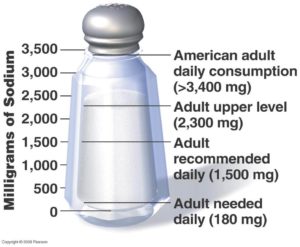
What should my daily sodium intake be?
The American Heart Association recommends no more than 2,300 milligrams (mg) a day and an ideal limit of no more than 1,500 mg per day for most adults.
Because the average American’s sodium intake is so excessive, even cutting back to no more than 2,400 milligrams a day will significantly improve blood pressure and heart health.
More than 75 percent of the sodium Americans eat comes from processed, prepackaged, and restaurant foods – not from the salt shaker.
Here are the approximate amounts of sodium in a given amount of table salt:
- 1/4 teaspoon salt = 575 mg. sodium
- 1/2 teaspoon salt = 1,150 mg. sodium
- 3/4 teaspoon salt = 1,725 mg. sodium
- 1 teaspoon salt = 2,300 mg. sodium
Did you know that on average, Americans eat more than 3,400 milligrams of sodium each day — much more than the American Heart Association and other health organizations recommend? Most of us are likely underestimating how much sodium we eat if we can estimate it at all. The association surveyed 1,000 adults and found that one-third couldn’t estimate how much sodium they ate, and another 54 percent thought they were eating less than 2,000 mg sodium a day.
How can I tell how much sodium I’m eating?
You can find the amount of sodium in your food by looking at the Nutrition Facts label. The amount of sodium per serving is listed in milligrams, abbreviated “mg.” Check the ingredient list for words like sodium, salt, and soda. The total sodium shown on the Nutrition Facts label includes the sodium from salt, plus the sodium from any other sodium-containing ingredient in the product (for example, ingredients like sodium nitrate, sodium citrate, monosodium glutamate [MSG], or sodium benzoate).
Remember to take note of the serving size on the Nutrition Facts label. If your portion size equals two servings of a product, you’re eating double the sodium listed.
Here are sodium-related terms you may see on food packages:
- Sodium-free – Less than 5 milligrams of sodium per serving and contains no sodium chloride
- Very low sodium – 35 milligrams or less per serving
- Low sodium – 140 milligrams or less per serving
- Reduced (or less) sodium – At least 25 percent less sodium per serving than the usual sodium level
- Light (for sodium-reduced products – If the food is “low calorie” and “low fat” and sodium is reduced by at least 50 percent per serving
- Light in sodium – If sodium is reduced by at least 50 percent per serving
Keep tabs on how much sodium you’re eating. Just jot down what you eat — that blueberry muffin for breakfast, or the garlic bread with last night’s spaghetti — and the accompanying sodium stats. Remember: Sodium levels vary in the same foods depending on the brand or restaurant.
At the end of the day, it’s easy to tally how much sodium you consumed so you can make better choices as needed. Sometimes a slight adjustment can bring significant results when it comes to your health!
Source: American Heart Association
